Topics
Category
Era
Common Loon
A migratory diver of the loon family, the common loon (Gavia immer) has been important to people living in the Great Lakes region for hundreds, if not thousands, of years. Its striking calls and black-and-white summer plumage have made it an emblem of Minnesota, where more of the birds live than in any other state except Alaska. The loon became Minnesota’s state bird in 1961.
Adult loons weigh eight to twelve pounds and are shaped like torpedoes. Their summer plumage is a spotted white and black, with iridescence on the head; in winter, that coloring changes to gray and white. Males can be a bit larger than females, but in all other ways they are identical.
Loons have four calls: the yodel, the wail, the hoot, and the tremolo. They live on lakes in central and northern Minnesota but migrate south every September to the Atlantic coast (their northern range includes the northern US and Canada) before returning north in the spring. Their bones, unlike those of most birds, are not hollow, allowing them to dive deep underwater for their food: small fish, minnows, amphibians, insects, crayfish, and mollusks.
The loon (maang in Ojibwemowin) is culturally important to Ojibwe people. It plays a role in some versions of Ojibwe creation stories, while other legends connect Maang to Nanaboozho, an Ojibwe cultural hero. It is said that when Maang calls in the rain at dusk, the bird is calling for Nanaboozho. Many Ojibwe people are members of the Maang Doodem (Loon Clan), and Maang is sacred to them. It is taboo for a member of the Maang Doodem to harm a loon or to marry another member of the clan.
In Ojibwe culture, clans are named after animals (or parts of animals) and perform distinctive roles. The members of bird clans, such as the Crane and the Loon, take on civil leadership roles. Members of the Maang Doodem historically served as diplomats, often leading negotiations until a member of the Crane Clan (Ajijaak Doodem) offered final decisions. “Leading with your Loon'' is an Ojibwe teaching today that encourages people to be diplomatic with others. Dakota people call the loon Mdóza and have incorporated some elements of it into their culture as well.
As white settlers entered Minnesota in the 1800s, the loon population declined due to hunting and habitat destruction. The Migratory Bird Treaty Act of 1918 prohibited the taking of loons without the authorization of the Department of the Interior’s Fish and Wildlife Service. Though protected from overhunting, loon habitat continued to decline in the 1920s due to residential development and summer vacationers in northern Minnesota. In the 1930s, loons began to disappear from central and southern Minnesota lakes.
The loon became Minnesota’s state bird in 1961. Spurred by the work of Dr. Judith McIntyre and the Minnesota Department of Natural Resources, programs focused on protecting and learning more about the state’s loons began in the 1970s. In 1977, Minnesota’s Nongame Wildlife Program started raising funds to conserve Minnesota’s nongame species. The investment paid off. By 1989, the loon was struggling across the US but not in Minnesota, where there were an estimated 10,000 loons for the state’s 10,000 lakes.
To gather more information about the state’s loon population, the Minnesota Department of Natural Resources began a loon-monitoring program in 1994. After the 2010 Deepwater Horizon oil rig explosion killed thousands of loons overwintering in the Gulf of Mexico, a settlement awarded Minnesota $7.52 million as compensation for injury to its natural resources. The money has been used to support Minnesota’s Loon Restoration Project, which focuses on eight counties in north-central Minnesota.
The loon is a Minnesota icon, and organizations have adopted it as their emblem. When the Minnesota State Lottery began in 1989, it used the loon as its logo to remind people that some lottery earnings supported state conservation programs. In 2002 a loon design became an option on Minnesota license plates, and in 2005, it was put on the state quarter. The Minnesota United FC, Minnesota’s professional men’s soccer club, started using a stylized loon logo in 2013. The team is often called “the Loons.” And in May 2024, Minnesota adopted a new state seal featuring a loon at its center.
Also in 2024, the International Union for Conservation of Nature (IUCN) rated the loon a species of “Least Concern” for extinction, and the bird continued to return to its range south of the Twin Cities. In spite of these gains, however, climate change, pollution, habitat loss, disturbance by humans, and use of lead fishing weights continue to threaten the loon population in Minnesota.
Bibliography
Associated Press. “Loony Over Loons.” Brainerd Dispatch, June 9, 2003.
https://www.brainerddispatch.com/sports/loony-over-loons
Audubon Society. How Climate Change Will Affect Birds in Minnesota.
https://www.audubon.org/climate/survivalbydegrees/state/us/mn
Biodiversity Research Institute. Loon Program—Minnesota.
https://briwildlife.org/loon-program/minnesota-loons
“Captive Loon Taken to University for Study.” Pelican Rapids Press, December 4, 1969.
https://www.mnhs.org/newspapers/lccn/sn89064364/1969-12-04/ed-1/seq-1
Cloud, Gerald. “Strangling Geese.” News From The Sloughs (Bad River, MN), April 1, 1997.
Costantini, Allen. “Minnesota Lottery Turns 25, Shows Off New Logo.” Kare 11, April 17, 2014.
https://www.kare11.com/article/news/minnesota-lottery-turns-25-shows-off-new-logo/89-107329150
Dakota Online Dictionary.
https://dictionary.swodli.com
Hirsch, Katherine V. “Loon On Our Northern Waters.” Naturalist 32, no. 4 (Winter 1981): 17–19.
Hollatz, Tom, with Corinne Dwyer. The Loon Book. North Star Press, 1984.
Klein, Tom. Loon Magic. Paper Birch Press, 1985.
Legislature of the State of Minnesota. “An Act Designating the Loon as the Minnesota State Bird.” Session Laws, Chapter 76—H.F. No. 79, March 13, 1961.
https://www.revisor.mn.gov/laws/1961/0/Session+Law/Chapter/76/pdf
“The Loon Dodges Bullets and Scares Hunters.” Minneapolis Journal, June 1, 1901.
https://www.mnhs.org/newspapers/lccn/sn83045366/1901-06-01/ed-1/seq-25
McIntyre, Judith W. The Common Loon: Spirit of Northern Lakes. University of Minnesota Press, 1988.
Minnesota Department of Natural Resources. Common Loon.
https://www.dnr.state.mn.us/birds/commonloon.html
Minnesota Department of Natural Resources. Minnesota Loon Restoration Project.
https://www.dnr.state.mn.us/eco/nongame/minnesota-loon-restoration-project.html
Minnesota Ornithologists Union. The Loon archive.
https://moumn.org/loon/atomz.php
Minnesota United FC.
https://www.mnufc.com
Office of the Minnesota Secretary of State. State Bird—Loon.
https://www.sos.state.mn.us/about-minnesota/state-symbols/state-bird-loon
Ogimaagiizhig Odoodeman Adikwan (Charles Grolla). Binesi-Dibaajimowinan: Ojibwe Bird Stories Unique to Northern Minnesota. Leech Lake Tribal College Design & Print Shop, 2019.
Ojibwe People’s Dictionary.
https://ojibwe.lib.umn.edu
Rossman, George. The Loon: Minnesota’s State Bird. N.p., 1967.
Strong, Paul I. V. “An Estimate of Minnesota’s Summer Population of Adult Common Loons. Minnesota.” Department of Natural Resources Biological Report no. 37, 1991.
https://www.lrl.mn.gov/docs/2015/other/155091.pdf
Thayer, B. W. “‘Mong, the Loon: Symbolic Bird of the Ojibwa.” Minnesota Archaeologist 24, no. 2 (July 1962): 84–85.
“Traditional Chippewa Tribal Government.” Chapter 1 in Minnesota Chippewa Tribe Government Student Handbook. Minnesota Chippewa Tribe, 1978.
Treuer, Anton. “Ojibwe Clans.” YouTube video, March 28, 2021.
https://www.youtube.com/watch?v=iP2_TZYq8Y8
United States Fish and Wildlife Service. Migratory Bird Treaty Act of 1918.
https://www.fws.gov/law/migratory-bird-treaty-act-1918
United States Mint. Minnesota State Quarter.
https://www.usmint.gov/coins/coin-medal-programs/50-state-quarters/minnesota
Vandegrift, Greg. “Everyday Minnesotans Help Protect State’s Treasure: The Loon.” Kare 11, September 27, 2021.
https://www.kare11.com/article/news/local/kare11-extras/everyday-minnesotans-help-protect-the-loon/89-4e273bfc-90f3-454b-a6f2-c5d611d98de1
Wacker, Erica. “How Minnesota Could Lose the Loon.” Minnesota Monthly, August 18, 2021.
https://www.minnesotamonthly.com/travel-recreation/how-minnesota-could-lose-the-loon
Warren, William W. History of the Ojibway People. St. Paul: Minnesota Historical Society Press, 1984.
https://archive.org/details/historyojibways00nielgoog
Related Resources
Secondary
Dunning, Joan. The Loon: Voice of the Wilderness. Yankee Books, 1985.
Hutchinson, Alan. Just Loons: A Wildlife Watchers Guide. Willow Creek Press, 1998.
Web
“The Great Northern Diver: Having Seen the Loon At Home On The Water, No Sensible Person Could Call It ‘Crazy.’” Minneapolis Journal, June 13, 1903.
https://www.mnhs.org/newspapers/lccn/sn83045366/1903-06-13/ed-1/seq-1
Minnesota Breeding Bird Atlas. Common Loon.
https://mnbirdatlas.org/species/common-loon
National Loon Center.
https://www.nationallooncenter.org
Northern Waters Land Trust. Minnesota Loon Restoration Project.
https://northernwaterslandtrust.org/mn-dnr-loon-restoration-project
Related Audio
MN90: Minnesota’s State Bird
It isn’t a Minnesota summer without the sound of a loon coming off the lake. Producer Britt Aamodt wonders, “What are all those sounds the loon makes, and what do they mean?”
All rights reserved
Holding Location
More Information
Articles
Related Images
“Maang Doodem / Loon Clan.” Acrylic and ink painting by Sam Zimmerman (Zhaawanoogiizhik), January 2020. Used with the permission of Sam Zimmerman. Featured in Following My Spirit Home: A Collection of Paintings and Stories (Minnesota Historical Society, 2022), 42–43. Zimmerman writes in that book, “I envisioned a maang family swimming along the shore. He is breaking the surface to answer his mate’s call, his mate carrying their young chick on his back. I went with softer brush strokes for the sky to capture a more calm and peaceful scene.”
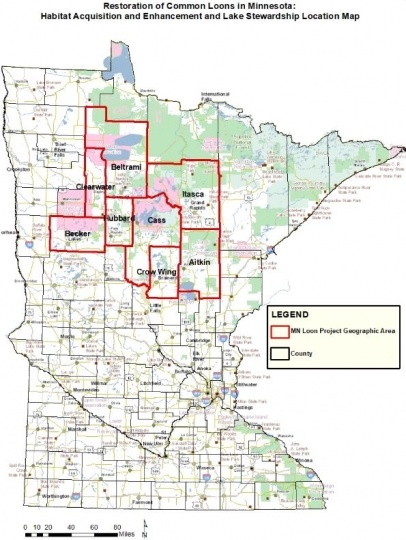
Minnesota Loon Restoration Project map
Map highlighting the eight counties where Minnesota’s Loon Restoration Project is taking place, 2024. Minnesota Department of Natural Resources.
Holding Location
Articles
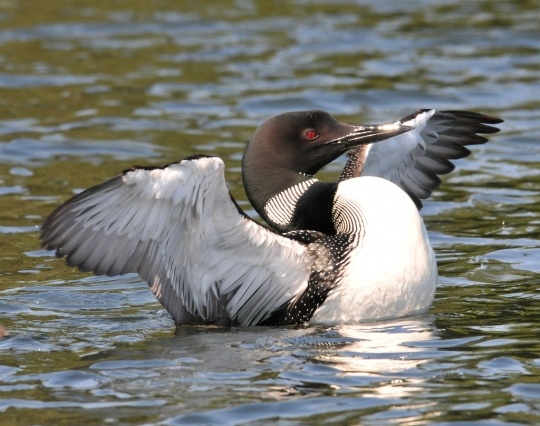
A loon stretching
A common loon photographed by Amy Widenhofer, 2012. CC BY-SA 2.0
Holding Location
Articles
More Information
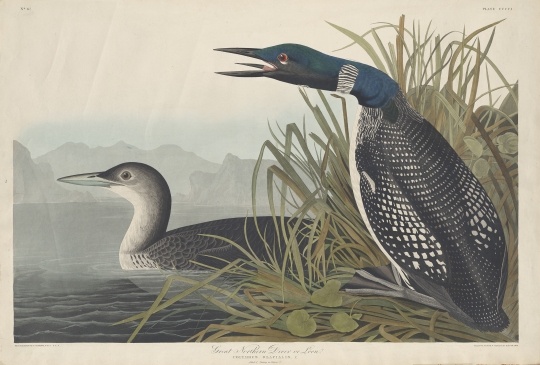
Etching of two loons by John James Audubon
Etching of two loons by John James Audubon, 1836.
Holding Location
Articles
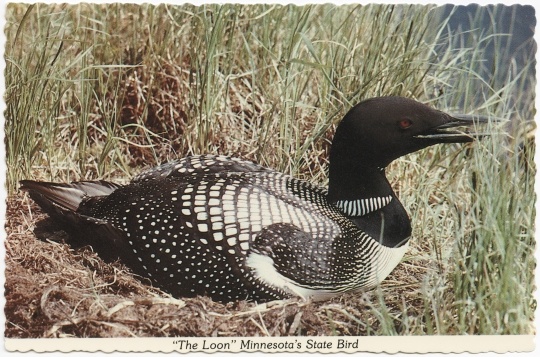
Loon postcard
Loon postcard, ca. 1980.
Holding Location
Articles

Minnesota DNR Loon sign
Minnesota DNR (Department of Natural Resources) loon nesting sign, ca. 1988.
Holding Location
Articles
_in_the_Morro_Bay.jpg)
Loon emerging from water
A common loon emerging from water in Morro Bay, California, November 25, 2007. Photograph by Wikimedia Commons user Mike Baird. CC BY 2.0
Holding Location
Articles
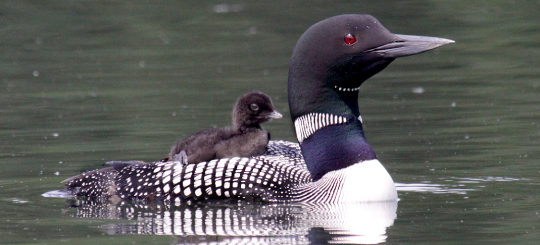
A loon with a chick on its back
A common loon (Gavia Immer) with a chick on its back, ca. 2010.
Holding Location
Articles
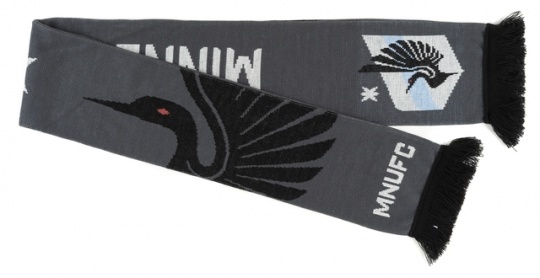
Scarf with Minnesota United FC logo
Scarf featuring the stylized loon emblem of the Minnesota United FC soccer team, ca. 2013.
Holding Location
Articles
.jpeg)
Loon in the Boundary Waters
A loon in the Boundary Waters Canoe Area Wilderness inside Minnesota. Photograph by Wikimedia Commons user Albert Maruggi, January 15, 2018. CC BY 3.0
Holding Location
Articles
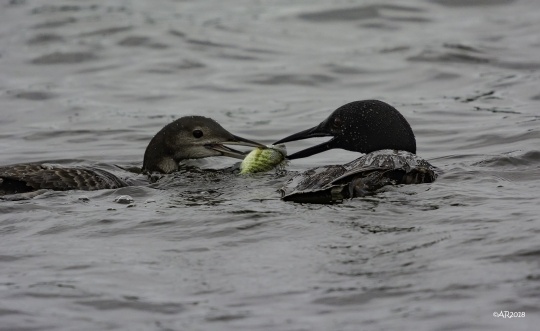
Loons with a perch
Two loons with a perch on Upper Hay Lake near Pequot Lakes, Minnesota. Photograph by Anita Ritenour, August 25, 2018. CC BY 2.0
Holding Location
Articles
More Information
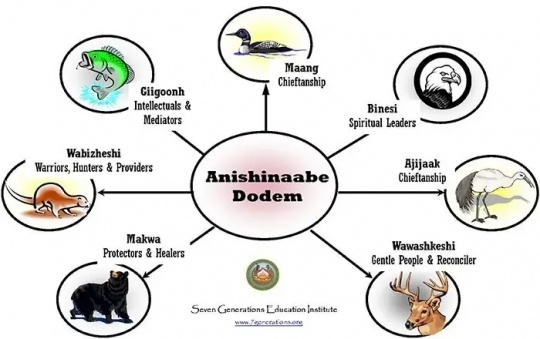
Diagram of Anishinaabe doodem (clans)
A diagram of the seven Anishinaabe doodem (clans) featuring the maang (loon) at the top.
Articles
More Information
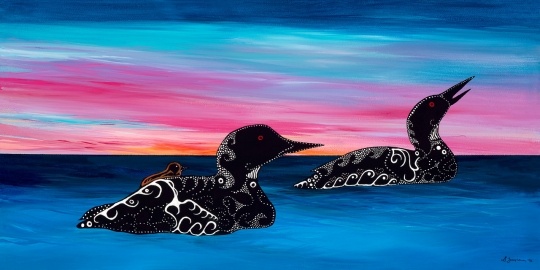
“Maang Doodem / Loon Clan”
“Maang Doodem / Loon Clan.” Acrylic and ink painting by Sam Zimmerman (Zhaawanoogiizhik), January 2020. Used with the permission of Sam Zimmerman. Featured in Following My Spirit Home: A Collection of Paintings and Stories (Minnesota Historical Society, 2022), 42–43. Zimmerman writes in that book, “I envisioned a maang family swimming along the shore. He is breaking the surface to answer his mate’s call, his mate carrying their young chick on his back. I went with softer brush strokes for the sky to capture a more calm and peaceful scene.”
All rights reserved
Holding Location
Articles

Minnesota Loon Restoration Project map
Map highlighting the eight counties where Minnesota’s Loon Restoration Project is taking place, 2024. Minnesota Department of Natural Resources.
Holding Location
Articles

A loon stretching
A common loon photographed by Amy Widenhofer, 2012. CC BY-SA 2.0
Holding Location
Articles
More Information

Etching of two loons by John James Audubon
Etching of two loons by John James Audubon, 1836.
Holding Location
Articles

Loon postcard
Loon postcard, ca. 1980.
Holding Location
Articles

Minnesota DNR Loon sign
Minnesota DNR (Department of Natural Resources) loon nesting sign, ca. 1988.
Holding Location
Articles
_in_the_Morro_Bay.jpg)
Loon emerging from water
A common loon emerging from water in Morro Bay, California, November 25, 2007. Photograph by Wikimedia Commons user Mike Baird. CC BY 2.0
Holding Location
Articles

A loon with a chick on its back
A common loon (Gavia Immer) with a chick on its back, ca. 2010.
Holding Location
Articles

Scarf with Minnesota United FC logo
Scarf featuring the stylized loon emblem of the Minnesota United FC soccer team, ca. 2013.
Holding Location
Articles
.jpeg)
Loon in the Boundary Waters
A loon in the Boundary Waters Canoe Area Wilderness inside Minnesota. Photograph by Wikimedia Commons user Albert Maruggi, January 15, 2018. CC BY 3.0
Holding Location
Articles

Loons with a perch
Two loons with a perch on Upper Hay Lake near Pequot Lakes, Minnesota. Photograph by Anita Ritenour, August 25, 2018. CC BY 2.0
Holding Location
Articles
More Information

Diagram of Anishinaabe doodem (clans)
A diagram of the seven Anishinaabe doodem (clans) featuring the maang (loon) at the top.
Articles
More Information

“Maang Doodem / Loon Clan”
“Maang Doodem / Loon Clan.” Acrylic and ink painting by Sam Zimmerman (Zhaawanoogiizhik), January 2020. Used with the permission of Sam Zimmerman. Featured in Following My Spirit Home: A Collection of Paintings and Stories (Minnesota Historical Society, 2022), 42–43. Zimmerman writes in that book, “I envisioned a maang family swimming along the shore. He is breaking the surface to answer his mate’s call, his mate carrying their young chick on his back. I went with softer brush strokes for the sky to capture a more calm and peaceful scene.”
All rights reserved
Holding Location
Articles

Minnesota Loon Restoration Project map
Map highlighting the eight counties where Minnesota’s Loon Restoration Project is taking place, 2024. Minnesota Department of Natural Resources.
Holding Location
Articles
Related Articles
Turning Point
In 1977, Minnesota's Nongame Wildlife Program begins raising money for non-game species conservation across the state. The loon population stabilizes at 10,000 by 1989.
Chronology
1830
ca. 1842–1845
1918
1932
1961
mid-1960s
early 1970s
1977
1979
1982
1989
1994
ca. 2004
2010
2019
2024
Bibliography
Associated Press. “Loony Over Loons.” Brainerd Dispatch, June 9, 2003.
https://www.brainerddispatch.com/sports/loony-over-loons
Audubon Society. How Climate Change Will Affect Birds in Minnesota.
https://www.audubon.org/climate/survivalbydegrees/state/us/mn
Biodiversity Research Institute. Loon Program—Minnesota.
https://briwildlife.org/loon-program/minnesota-loons
“Captive Loon Taken to University for Study.” Pelican Rapids Press, December 4, 1969.
https://www.mnhs.org/newspapers/lccn/sn89064364/1969-12-04/ed-1/seq-1
Cloud, Gerald. “Strangling Geese.” News From The Sloughs (Bad River, MN), April 1, 1997.
Costantini, Allen. “Minnesota Lottery Turns 25, Shows Off New Logo.” Kare 11, April 17, 2014.
https://www.kare11.com/article/news/minnesota-lottery-turns-25-shows-off-new-logo/89-107329150
Dakota Online Dictionary.
https://dictionary.swodli.com
Hirsch, Katherine V. “Loon On Our Northern Waters.” Naturalist 32, no. 4 (Winter 1981): 17–19.
Hollatz, Tom, with Corinne Dwyer. The Loon Book. North Star Press, 1984.
Klein, Tom. Loon Magic. Paper Birch Press, 1985.
Legislature of the State of Minnesota. “An Act Designating the Loon as the Minnesota State Bird.” Session Laws, Chapter 76—H.F. No. 79, March 13, 1961.
https://www.revisor.mn.gov/laws/1961/0/Session+Law/Chapter/76/pdf
“The Loon Dodges Bullets and Scares Hunters.” Minneapolis Journal, June 1, 1901.
https://www.mnhs.org/newspapers/lccn/sn83045366/1901-06-01/ed-1/seq-25
McIntyre, Judith W. The Common Loon: Spirit of Northern Lakes. University of Minnesota Press, 1988.
Minnesota Department of Natural Resources. Common Loon.
https://www.dnr.state.mn.us/birds/commonloon.html
Minnesota Department of Natural Resources. Minnesota Loon Restoration Project.
https://www.dnr.state.mn.us/eco/nongame/minnesota-loon-restoration-project.html
Minnesota Ornithologists Union. The Loon archive.
https://moumn.org/loon/atomz.php
Minnesota United FC.
https://www.mnufc.com
Office of the Minnesota Secretary of State. State Bird—Loon.
https://www.sos.state.mn.us/about-minnesota/state-symbols/state-bird-loon
Ogimaagiizhig Odoodeman Adikwan (Charles Grolla). Binesi-Dibaajimowinan: Ojibwe Bird Stories Unique to Northern Minnesota. Leech Lake Tribal College Design & Print Shop, 2019.
Ojibwe People’s Dictionary.
https://ojibwe.lib.umn.edu
Rossman, George. The Loon: Minnesota’s State Bird. N.p., 1967.
Strong, Paul I. V. “An Estimate of Minnesota’s Summer Population of Adult Common Loons. Minnesota.” Department of Natural Resources Biological Report no. 37, 1991.
https://www.lrl.mn.gov/docs/2015/other/155091.pdf
Thayer, B. W. “‘Mong, the Loon: Symbolic Bird of the Ojibwa.” Minnesota Archaeologist 24, no. 2 (July 1962): 84–85.
“Traditional Chippewa Tribal Government.” Chapter 1 in Minnesota Chippewa Tribe Government Student Handbook. Minnesota Chippewa Tribe, 1978.
Treuer, Anton. “Ojibwe Clans.” YouTube video, March 28, 2021.
https://www.youtube.com/watch?v=iP2_TZYq8Y8
United States Fish and Wildlife Service. Migratory Bird Treaty Act of 1918.
https://www.fws.gov/law/migratory-bird-treaty-act-1918
United States Mint. Minnesota State Quarter.
https://www.usmint.gov/coins/coin-medal-programs/50-state-quarters/minnesota
Vandegrift, Greg. “Everyday Minnesotans Help Protect State’s Treasure: The Loon.” Kare 11, September 27, 2021.
https://www.kare11.com/article/news/local/kare11-extras/everyday-minnesotans-help-protect-the-loon/89-4e273bfc-90f3-454b-a6f2-c5d611d98de1
Wacker, Erica. “How Minnesota Could Lose the Loon.” Minnesota Monthly, August 18, 2021.
https://www.minnesotamonthly.com/travel-recreation/how-minnesota-could-lose-the-loon
Warren, William W. History of the Ojibway People. St. Paul: Minnesota Historical Society Press, 1984.
https://archive.org/details/historyojibways00nielgoog
Related Resources
Secondary
Dunning, Joan. The Loon: Voice of the Wilderness. Yankee Books, 1985.
Hutchinson, Alan. Just Loons: A Wildlife Watchers Guide. Willow Creek Press, 1998.
Web
“The Great Northern Diver: Having Seen the Loon At Home On The Water, No Sensible Person Could Call It ‘Crazy.’” Minneapolis Journal, June 13, 1903.
https://www.mnhs.org/newspapers/lccn/sn83045366/1903-06-13/ed-1/seq-1
Minnesota Breeding Bird Atlas. Common Loon.
https://mnbirdatlas.org/species/common-loon
National Loon Center.
https://www.nationallooncenter.org
Northern Waters Land Trust. Minnesota Loon Restoration Project.
https://northernwaterslandtrust.org/mn-dnr-loon-restoration-project






_in_the_Morro_Bay.jpg?width=200&height=200&name=Common_Loon_(Gavia_immer)_in_the_Morro_Bay.jpg)


.jpeg?width=200&height=200&name=640px-Drops_On_A_Loon_(242546227).jpeg)



